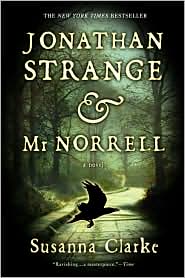Jonathan Strange & Mr. Norrell was published in 2004. When I first read it in February 2005 I wrote a review on my Livejournal (full review here), which I shall quote from because it is still my substantive reaction:
It’s set at the beginning of the nineteenth century, in an England that is the same but distorted by the operation of magic on history, and it concerns the bringing back of practical English magic.
What it’s about is the tension between the numinous and the known. The helical plot, which ascends slowly upwards, constantly circles a space in which the numinous and the known balance and shift and elements move between them. It’s a truly astonishing feat and I’ve never seen anything like it.
I’ve just read it again, and I could pretty much write that post again. In summary—this is terrific, it reads like something written in an alternate history in which Lud in the Mist was the significant book of twentieth century fantasy, and it goes directly at the the movement between magical and the mundane.
I wasn’t the only person to think this book was brilliant. It won the World Fantasy Award, it won the Hugo and the Mythopoeic, it was Time Magazine’s number one book of the year, a New York Times notable book, it was in the top ten of almost every publication in Britain and the U.S. and it was a huge international mega-bestseller. It did about as well as any book can do.
But five years later, it doesn’t seem to have had any impact. Sandcastle fantasy is being published all around as if Clarke had never put finger to keyboard. I wonder why that is?
It may be that it’s just too soon. Publishing is astonishingly slow. Books being published now were written several years ago. Influence does take time to permeate through. But wouldn’t you think that in five years you’d start to see some influence? But even without publishing speed, it could take longer than that for Clarke’s influence to be assimilated and reacted to. I shouldn’t be so impatient. Ten years might be a better measure.
Or maybe it will take a generation, maybe the people who read Clarke when they were teenagers will grow up to write fantasy influenced by her, but it’s not going to happen with people already grown up and publishing and set in their ways?
Perhaps it’s just sui generis, so wonderful and unique that it can’t really be an influence except as a spur to excellence?
Or maybe, in the same way it doesn’t appear to have a much in the way of immediate ancestors, it can’t produce descendants? It’s wonderful, but it’s not what fantasy is, it isn’t in dialogue with fantasy and it’s hard for fantasy to engage with it?
After all, what do I mean by influence? There’s plenty of fantasy set in Regency England—there’s Novik’s Temeraire for a start. I don’t think we should have a sudden rash of books about Napoleonic magic or books with charming footnotes containing short stories. I don’t even want more books directly using faerie magic. (We have had some of those too.)
What I would have thought I’d have seen by now is stories that acknowledge the shadow Jonathan Strange & Mr Norrell cast across the possibilities, things that attempt to engage with the numinous in the way it does. Fantasy is all about ways of approaching the numinous—and everything I read is still using the traditional approaches. That’s what I keep hoping for and not seeing.
Perhaps it will happen, given time.
Meanwhile, Jonathan Strange & Mr Norrell is there, it’s incredible, and one can always read it again.
Jo Walton is a science fiction and fantasy writer. She’s published eight novels, most recently Half a Crown and Lifelode, and two poetry collections. She reads a lot, and blogs about it here regularly. She comes from Wales but lives in Montreal where the food and books are more varied.










